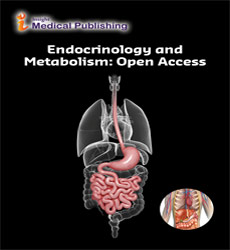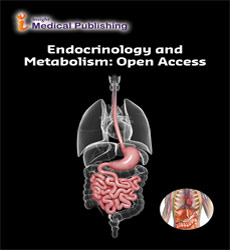The Role of Gut Microbiota in Endocrine Regulation and Metabolic Health
Alba Valentin*
Department of Molecular and Translational Science, Monash University, Melbourne, VIC 3168, Australia
*Corresponding author:
Alba Valentin,
Department of Molecular and Translational Science, Monash University, Melbourne, VIC 3168, Australia,
E-mail: valentin.alba@hudson.org.au
Received date: February 01, 2025, Manuscript No. ipemoa-25-20741; Editor assigned date: February 03, 2025, PreQC No. ipemoa-25-20741 (PQ); Reviewed date: February 15, 2025, QC No. ipemoa-25-20741; Revised date: February 22, 2025, Manuscript No. ipemoa-25-20741 (R); Published date: February 28, 2025
Citation: Valentin A (2025) The Role of Gut Microbiota in Endocrine Regulation and Metabolic Health. Endocrinol Metab Vol.09 No.1:04
Introduction
The gut microbiota, a complex and diverse community of microorganisms residing in the gastrointestinal tract, has emerged as a critical regulator of human physiology, extending far beyond digestion and nutrient absorption. Over the past two decades, research has increasingly demonstrated the influence of gut microbes on endocrine signaling, metabolic health, and disease susceptibility. The gut microbiome interacts with host systems through microbial metabolites, modulation of inflammatory pathways, and cross-talk with endocrine axes, thereby affecting processes such as glucose homeostasis, lipid metabolism, appetite regulation, and energy expenditure. Disruption of microbial composition commonly referred to as dysbiosis has been implicated in obesity, insulin resistance, type 2 diabetes mellitus, and other metabolic disorders. Understanding the role of gut microbiota in endocrine regulation provides a new perspective on metabolic health and offers novel therapeutic opportunities in clinical practice [1].
Description
The gut microbiota is composed of trillions of bacteria, viruses, fungi, and archaea, dominated mainly by the bacterial phyla Firmicutes and Bacteroidetes. These microbial communities exist in a symbiotic relationship with the host, performing essential functions including fermentation of indigestible dietary components, synthesis of vitamins, and regulation of immune responses. Beyond these fundamental roles, gut microbes produce bioactive metabolites such as Short-Chain Fatty Acids (SCFAs), bile acid derivatives, and neurotransmitter-like molecules that serve as key mediators of endocrine regulation.
One of the most well-studied contributions of gut microbiota to endocrine regulation is the production of SCFAs-acetate, propionate, and butyrate through fermentation of dietary fiber.
SCFAs act as signaling molecules by binding to G-protein-coupled receptors (e.g., GPR41 and GPR43) expressed in intestinal epithelial cells, adipose tissue, and pancreatic β-cells. This interaction influences the secretion of incretin hormones such as Glucagon-Like Peptide-1 (GLP-1) and peptide YY (PYY), which play pivotal roles in regulating insulin release, appetite suppression, and energy homeostasis. Butyrate, in particular, exerts anti-inflammatory effects and supports intestinal barrier integrity, reducing systemic inflammation that contributes to insulin resistance and metabolic dysfunction [2].
Gut microbiota also modulate bile acid metabolism, which directly influences endocrine signaling pathways. Primary bile acids synthesized in the liver are modified by gut bacteria into secondary bile acids that activate receptors such as the farnesoid X receptor (FXR) and Takeda G-Protein Receptor 5 (TGR5). Activation of these receptors impacts glucose metabolism, lipid regulation, and energy expenditure. For instance, TGR5 stimulation enhances GLP-1 secretion and promotes thermogenesis in brown adipose tissue, thereby improving glucose tolerance and reducing adiposity [1]. Dysbiosis that disrupts bile acid transformation has been linked to impaired glucose regulation and heightened cardiovascular risk. Another important axis of gut microbiotaâ??endocrine interaction is the regulation of the Hypothalamic-Pituitary-Adrenal (HPA) axis. The microbiome influences stress responses by modulating cortisol levels through immune and neural pathways. Dysbiosis has been associated with hyperactivation of the HPA axis, contributing to metabolic complications such as visceral obesity and insulin resistance. Similarly, microbial metabolites can influence the Hypothalamic-Pituitary-Thyroid (HPT) axis, where iodine metabolism and thyroid hormone activity may be indirectly modulated by gut bacteria, thereby affecting basal metabolic rate and energy expenditure [2].
The gut microbiota also plays a role in appetite regulation via communication with the central nervous system through the gutâ??brain axis. SCFAs, bacterial peptides, and neurotransmitter-like molecules (e.g., gamma-aminobutyric acid, serotonin, and dopamine precursors) influence vagal signaling and hypothalamic appetite centers. Approximately 90% of the bodyâ??s serotonin is produced in the gut, and microbial regulation of tryptophan metabolism can alter serotonin synthesis, thereby influencing both mood and metabolic health.
Dysbiosis that disrupts this axis has been linked to overeating, weight gain, and obesity-related metabolic dysfunction. In addition to direct hormonal modulation, gut microbiota contribute to systemic inflammation, a key driver of metabolic disorders. Dysbiosis promotes increased intestinal permeability, allowing LipoPolySaccharides (LPS) and other microbial products to enter circulation, triggering low-grade chronic inflammation. This inflammatory state interferes with insulin receptor signaling in skeletal muscle and adipose tissue, accelerates atherosclerosis, and heightens cardiovascular risk. Hence, the endocrine effects of gut microbiota extend to immunometabolic regulation.
Conclusion
The gut microbiota represents a central player in endocrine regulation and metabolic health, influencing host physiology through mechanisms that extend far beyond digestion. By modulating incretin release, bile acid signaling, neurohormonal axes, and appetite regulation, gut microbes orchestrate complex interactions that shape glucose homeostasis, lipid metabolism, and energy balance.
Dysbiosis contributes to obesity, insulin resistance, and type 2 diabetes via chronic inflammation and impaired endocrine signaling, underscoring its role as a mediator of metabolic disease. Emerging therapeutic strategies ranging from dietary interventions and probiotics to advanced approaches like microbiota transplantation and personalized nutrition offer promising avenues for restoring microbial balance and improving metabolic outcomes. As research continues to uncover the intricacies of the gutâ??endocrine interface, harnessing the microbiotas potential may transform the prevention and management of metabolic disorders, advancing precision medicine in endocrinology.
Acknowledgement
None.
Conflict of Interest
None.
References
- Tong S, Ji Q, Du Y, Zhu X, Zhu C, et al. (2019) Sfrp5/Wnt Pathway:A Protective Regulatory System in Atherosclerotic Cardiovascular Disease. J Interferon Cytokine Res 39(8): 472-482.
Google Scholar Cross Ref Indexed at
- Hu W, Li L, Yang M, Luo X, Ran W, et al. (2013) Circulating Sfrp5 is a signature of obesity-related metabolic disorders and is regulated by glucose and liraglutide in humans. J Clin Endocrinol Metab 98(1): 290-298.

Open Access Journals
- Aquaculture & Veterinary Science
- Chemistry & Chemical Sciences
- Clinical Sciences
- Engineering
- General Science
- Genetics & Molecular Biology
- Health Care & Nursing
- Immunology & Microbiology
- Materials Science
- Mathematics & Physics
- Medical Sciences
- Neurology & Psychiatry
- Oncology & Cancer Science
- Pharmaceutical Sciences
